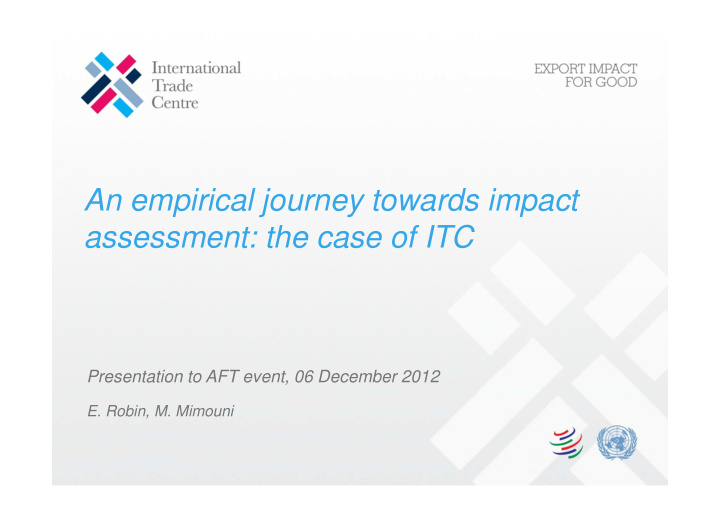



An empirical journey towards impact assessment: the case of ITC Presentation to AFT event, 06 December 2012 E. Robin, M. Mimouni
2 Overview • ITC’s approach to impact assessment • Impact assessment methodology • Challenges
3 RBM initiatives at corporate level • Corporate logframe leading to impact • Monitoring mechanism: corporate dashboard • Quality assessment policy & processes • Financial accountability
4 ITC’s approach to impact assessment NEEDS ASSESSMENT TARGET POPULATION/ BASELINE Project Design STRATEGIC OBJECTIVE 1: Improved availability and use of trade intelligence RBM STRATEGIC OBJECTIVE 2: Enhanced trade support monitoring institutions and policies for the benefit of exporting enterprises . Outputs STRATEGIC OBJECTIVE 3: Strengthened export capacity . Outcomes of enterprises to respond to market opportunities . Costing STRATEGIC OBJECTIVE 4: Increased level of sustainable and inclusive trade IMPACT ASSESSMENT JOBS & ENVIRONMENTAL EXPORTS INCOME SUSTAINABILITY
5 Areas of impact assessment • 3 areas suggested for assessing overall ITC’s impact: • Trade and economic impact indicators (11) • Environment impact indicators (5) • Gender impact indicators (4) • Other impact indicators that would be project related (eg: social impact indicators from Ethical Fashion Project) • Impact related to new topics
6 Areas of impact assessment: Corporate level • 3 areas suggested for assessing ITC’s impact: • Trade and economic impact indicators (11) – Increase of sectoral exports – Increase of regional exports – Increase of national exports Trade – Increase of enterprise’s exports – Number of new markets which enterprise is exporting to – Increase in value of trade turnover – Number of new products produced by the enterprise for export (diversification) – Number of jobs created Others – Decrease in number of administrative documents – Decrease of transaction costs – Reduction of delays at custom borders • Environment impact indicators (5) • Gender impact indicators (4)
7 Areas of impact assessment: Corporate level • 3 areas suggested for assessing ITC’s impact: • Trade and economic impact indicators (11) • Environment impact indicators (5) – Increase of enterprise’s environmental exports – Increase in share of exports certified by environmental standards – Number of new environmental products produced by the enterprise for export – Increase in number of exporting enterprises enabled to comply with environmental certification requirements – Number of new markets which enterprise is exporting its environmental products to • Gender impact indicators (4)
8 Areas of impact assessment: Corporate level • 3 areas suggested for assessing ITC’s impact: • Trade and economic impact indicators (11) • Environment impact indicators (5) • Gender impact indicators (4) – Increase in women’s income earned – Number of jobs created for women – Increase of women owned enterprises' exports – Number of new markets which a women owned enterprise is exporting to
9 How to contact the sample to assess the impact ? • Large scale survey (Global Public Goods) + proxys � No direct contact with the final users • Direct contact with enterprises, with workshop participants or with other beneficiaries � Direct contact between beneficiary and ITC established during workshops, advisory services, missions • Survey implemented by TSIs for its beneficiaries � ITC’s direct beneficiaries are the TSIs but enterprises would be assessed • Trade statistics + proxys
10 Outcome indicators and impact assessment
11 ITC’s projects to be assessed Projects and beneficiaries Sample Global Public Goods – online tools 200 000 users 10 000 users 10 000 out of 200 000 Project I – capacity 1000 250 beneficiaries 250 out of 1 000 building beneficiaries Project II – advisory 2 TSIs 2 TSIs 2 out of 2 services Project III – capacity 50 out of 50 building + advisory 50 beneficiaries 50 beneficiaries services Need to merge all these contacts and to create one integrated survey system
12 ITC’s projects - sampling • Priority to partners benefiting from various ITC’s projects P. I 250 out of 1 000 GPG P. II 10 000 out of 200 000 P. III 2 out of 2 50 out of 50 Direct Total of survey participants: contact (with follow- Large up actions) ≠ 10000 + 250 + 2 + 50 scale survey = U(10000; 250; 2; 50) Survey implemented Direct by TSIs contact
13 Proposed guidelines for the ITC’s impact assessment • One unique ITC’s questionnaire: all questions (one per impact indicator) would be pre-established • Beneficiaries would be contacted only once • Way of contacting beneficiaries would depend on ITC’s relationship with them: • Direct contact: email, phone contact or offline survey • Contact through direct beneficiaries (for instance TSIs will implement the survey for their beneficiaries) • Large scale survey and proxys
14 Some challenges for the impact measurement and evaluation step: • Attribution remains the main challenge: difficult to attribute changes at the macro-level (e.g. changes in a country’s export performance) to micro-level interventions • Evaluations can be costly: investment in monitoring after project closure • Constraints related to data quality and availability: risk with some counterparts • Culture change in the organization Thank you for your attention
Recommend
More recommend